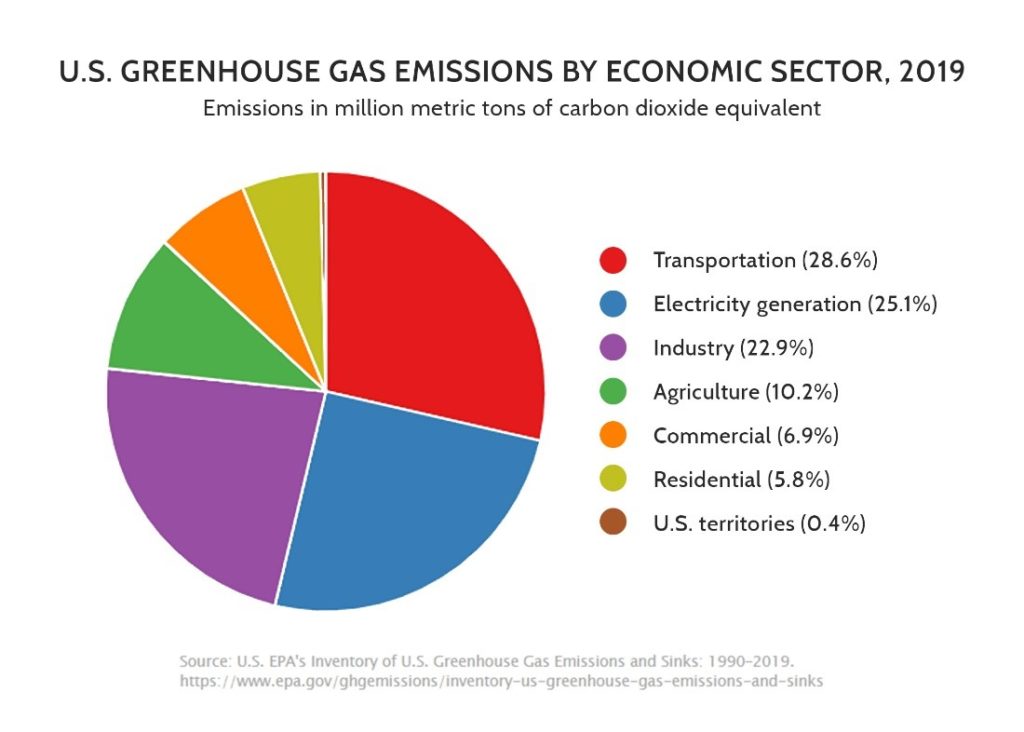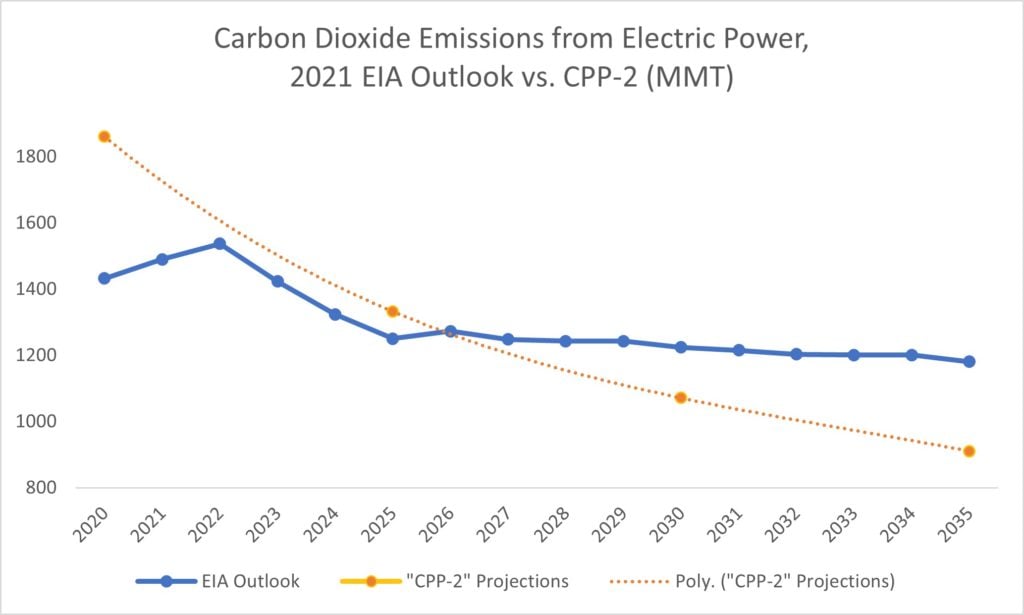Insight
June 2, 2021
Examining the NDC: Electricity Generation
Executive Summary
- The United States’ recent Nationally Determined Contribution (NDC) submission to the United Nations promises to achieve greenhouse gas reductions of 50-52 percent from 2005 levels by 2030 and establishes a goal of “100 percent carbon pollution-free electricity by 2035.”
- An analysis of a prominent regulatory proposal indicates that while an aggressive regulatory framework may reduce emissions substantially, it will likely fail to achieve this goal on its own.
- The experience of the Clean Power Plan indicates that any regulatory proposal would face a series of serious legal and implementation challenges, making it even more unlikely that a regulation-only approach to reducing emissions would work.
Introduction
On Earth Day, the Biden Administration notified the United Nations about how it intends to reduce greenhouse gas emissions in the United States, which was necessary following the country’s re-joining of the Paris Agreement. This brief document, known as the Nationally Determined Contribution (NDC), set an economy-wide target of reducing greenhouse gas emission by 50-52 percent from 2005 levels by 2030. The document approaches emissions reductions on a sector-by-sector basis, and the American Action Forum will release a series of analyses following that same sector-by-sector approach. This first analysis explores one potential regulatory scheme, the Clean Power Plan 2 (CPP-2), that the administration could rely on to reduce emissions in the electricity generation sector. Using this regulatory framework, this analysis estimates possible abatement potentials and costs.
In the likely absence of forthcoming legislation to implement the goals of the NDC, the administration is, in practical terms, largely left with needing to modify existing regulatory schemes to achieve its ends. This analysis of CPP-2 suggests, however, that regulations alone will not reduce emissions in this sector by sufficient levels to achieve the NDC’s goal. It also finds that such factors as insufficient practical ability, limited legal authority, rulemaking timelines, and potential litigation will further complicate achieving even the estimated reductions that CPP-2 could provide.
The Electricity Generation Sector and a “New” Clean Power Plan
Dramatic changes to the nation’s mix of electricity generation will be critical to any attempt at achieving the overall goals laid out in United States’ recent NDC. Per the most recent Environmental Protection Agency (EPA) data, the electricity generation sector is responsible for roughly one-quarter of all greenhouse gas emissions, second only to the transportation sector.

Beyond the current direct emissions from power plants, however, further efforts to “electrify” other sectors (e.g. transportation) will necessarily drive higher demand for electricity. This trend means that having a less carbon-intensive electricity system will become increasingly important over time. As such, the NDC boldly establishes a goal of “100 percent carbon pollution-free electricity by 2035.”[1]
Since Congress is unlikely to pass any stringent climate legislation any time soon, however, the administration is left to pursue its goals through a regulatory scheme, and one option is to build on the Obama-era Clean Power Plan. The regulatory framework discussed here comes from the modeled results of a “Clean Power Plan 2” (CPP-2) included in the Natural Resources Defense Council’s (NRDC) comment for the record regarding the Trump Administration’s replacement for the CPP, the “Affordable Clean Energy” (ACE) rule. This modeled framework has been cited in other recent analyses of decarbonization policies. As summarized by the first of those analyses, the CPP-2 “lowers the 2015 mass-based emissions caps by half, applies the standards to all existing fossil-fuel-fired facilities, controls the potential for leakage by constraining the emission rate from new natural gas builds to 100 pounds per megawatt-hour, allows national trading, and assumes a 1.5% incremental annual increase in demand-side energy efficiency.”[2]
The following graph illustrates NRDC’s expected carbon emissions under CPP-2 relative to the current baseline as estimated by the 2021 Energy Information Agency (EIA) Annual Energy Outlook (AEO), the federal government’s projections based upon current assumptions of energy market dynamics and relevant laws and regulations.

The NRDC model only includes results for 2025, 2030, and 2035 (with the 2020 point being the projected emissions for that year in the 2018 AEO). Also, since it comes from a 2018 analysis, its baseline assumptions and starting point are significantly higher than the more recent EIA projections. The disparity between its 2020 starting point and the 2020 estimate from the 2021 AEO is particularly striking but is likely due to A) continued market-level decarbonization trends in the intervening years and B) a historically anomalous decrease in emissions in 2020 induced by the diminished economic activity under the COVID-19 pandemic.
In 2026, the CPP-2 projections first fall below the current expected baseline, reaching a level of roughly 910 million metric tons of carbon dioxide (MMTCO2) in 2035[3] (270 MMTCO2 below the EIA projections). According to NRDC’s model, compliance costs to get to this point for the CPP-2 in 2030 range from $6.2 billion to $13.1 billion, depending upon how successfully states develop programs to increase energy efficiency year-over-year.[4] For comparison, according to the original CPP’s regulatory impact analysis (RIA), EPA estimated that the 2030 compliance costs for the mass-based approach would be $5.1 billion.[5]
Implications and Challenges
While it may appear that current emissions levels – and those in the near future – make a regulatory framework like the CPP-2 more achievable, it is important to consider certain practical and legal factors that likely make its achievement prohibitive absent some significant change in politics, technology, or the law. On the practical side, designing, drafting, and implementing regulations takes time. The original CPP was not finalized until the sixth year of the Obama Administration. It would take an atypically rushed process for the Biden Administration to fully implement something like this within the next year or so. Even generously granting that a CPP-2 equivalent is in place by 2024, that constrains the administration’s window of action for achieving its goal for 2035 emissions to 11 years as opposed to the 15 years given in the framework’s original projections. This shortened window means that relevant stakeholders would need to invest in more drastic – and expensive – abatement measures, barring significant technological improvements.
The other main hurdle for such a regulatory framework is its inherent legal status under current statute and precedents. In 2016, the Supreme Court granted a stay against the Clean Power Plan, concurring with petitioners that argued EPA did not have the legal authority to issue such a regulation. This past February, in light of the legal demise of the ACE rule, the D.C. Circuit Court opened up the possibility for the Biden Administration to pursue further rulemaking regarding power generation emissions. Given the legal challenges the original CPP faced, however, it would seem that attempting to implement a more rigorous and forceful version (such as CPP-2) likely puts it in even greater legal peril – especially considering that the current Supreme Court is widely thought to be nominally more conservative than its 2016 iteration. A regulatory framework in the vein of CPP-2 would most likely require either a significant update to the Clean Air Act or some dramatic change in judicial ruling on the subject.
Finally, there is the simple mathematical difference between the CPP-2’s projected reductions in emissions levels by 2035 and the NDC’s stated goal of a completely carbon-free electricity system by 2035. Taking the CPP-2’s projections at face-value, the electricity generation sector is still emitting approximately 910 MMTCO2 in 2035, which is 910 million away from (on-net) zero. Granted, there is a 429 MMTCO2 gap between the CPP-2’s original baseline in 2020 and current EIA estimates. Accounting for that and simply assuming a similar CPP-2 trajectory in reductions yields an emissions level of 481 MMTCO2—significantly closer to zero, but not yet there.
Conclusion
The NDC does mention pathways to its carbon-free electricity goal beyond simply regulatory action. For instance, it notes, “The United States will also support research, development, demonstration, commercialization, and deployment of software and hardware to support a carbon pollution-free, resilient, reliable, and affordable electricity system.”[6] As this analysis demonstrates, such support is for good reason. The projections of one of the more realistic potential regulatory frameworks available show that even such a program would not achieve that goal single-handedly. Furthermore, those projections fail to account for likely legal and practical challenges to the program’s implementation. Altogether, these barriers leave a regulatory-only approach as a unattractive option for achieving the NDC’s ambitious goal.
[1] The United States’ Nationally Determined Contribution Reducing Greenhouse Gases in the United States: A 2030 Emissions Target. April 2020. p. 3.
[2] Lambert, et al. Carbon Standards Re-Examined. Oct 19, 2020. p. 4.
[3] Lynch, et al. Comments of the Natural Resources Defense Council on EPA’s Proposed Emission Guidelines for Greenhouse Gas Emissions From Existing Electric Utility Generating Units; Revisions to Emission Guideline Implementing Regulations; Revisions to New Source Review Program. Oct 31, 2018. p. 14.
[4] Ibid. p. 23.
[5] U.S. Environmental Protection Agency. Regulatory Impact Analysis for the Clean Power Plan Final Rule. 2015. p. ES-9.
[6] The United States’ Nationally Determined Contribution Reducing Greenhouse Gases in the United States: A 2030 Emissions Target. April 2020. p. 3.










